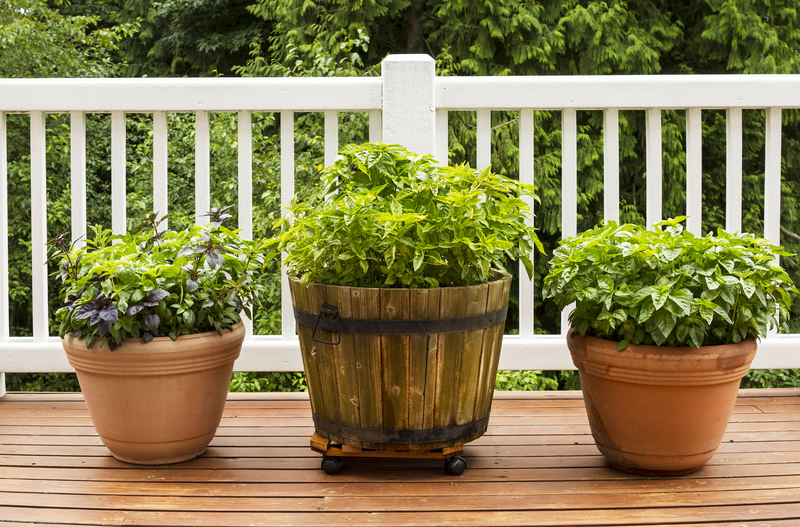Buffering Your Garden Against Strong Winds
Posted on 22/06/2025
Buffering Your Garden Against Strong Winds: Essential Tips for Protection
Gardening is a rewarding activity, but strong winds can pose significant challenges to plant health and the overall look of your outdoor space. Whether you live in a coastal area prone to gusts or simply want to safeguard your beloved blooms and vegetables from stormy surprises, creating a protective buffer is crucial. This comprehensive guide will show you how to buffer your garden against strong winds using strategic landscaping, structural supports, and smart plant selection.

Understanding the Impact of Strong Winds on Your Garden
High winds can cause a variety of problems in your garden. To effectively buffer your plants from wind damage, it's important to know the risks:
- Physical breakage of stems, branches, and even whole plants
- Increased evaporation: Wind strips moisture from soil and plant leaves, leading to drought stress
- Root disturbances: Uprooting and instability, especially in young or shallow-rooted plants
- Pollen dispersal issues: Disrupts pollination for some species
- Soil erosion: Wind can carry away topsoil and vital nutrients
By acknowledging these threats, you can take proven measures to protect your garden from severe winds and maintain a thriving landscape all year round.
Planning Wind Buffers: Designing a Protective Landscape
Site Assessment: Know Your Wind Patterns
Before installing any wind buffers, observe your garden's wind exposure. Notice:
- The direction of prevailing winds (often indicated by local weather apps or historical data)
- Natural windbreaks such as fences, hedges, or buildings already present
- Low-lying or exposed areas that could be most vulnerable to damage
*Identifying these factors will help you create a tailored approach to buffering your garden from strong winds.*
Strategic Placement of Wind Barriers
For effective wind buffering, place barriers on the windward side of your garden -- the side most exposed to incoming gusts. The best approach blends both natural windbreaks (living elements) and artificial windbreaks (man-made structures) for optimal protection.
Natural Windbreaks: Harnessing Plants as Living Shield
Benefits of Plant-Based Buffers
Utilizing trees, shrubs, and hedges as windbreaks not only shields your garden from high winds but also adds beauty, enhances privacy, and provides habitat for wildlife. Well-chosen plants can create a microclimate, fostering healthier, more resilient growth.
Best Plants for Wind Protection
For your garden wind buffer, choose hardy species known for their flexibility and dense branching. Consider:
- Evergreen trees like Pine, Spruce, or Juniper
- Deciduous trees such as Hawthorn or Willow (which bend rather than break)
- Hardy shrubs including Boxwood, Privet, or Viburnum
- Hedge-forming plants like Yew or Laurel
- Grass species in coastal or open landscapes, such as Muhly or Switchgrass
*Mixing plant varieties in layers--tall trees, medium shrubs, and groundcovers--creates a more effective wind buffer by reducing wind speed across different heights.*
Planting and Spacing Tips for Effective Windbreaks
- Stagger rows instead of planting in a straight line, allowing wind to filter and dissipate gradually
- Space plants appropriately so they'll grow dense over time without choking each other out
- Consider the mature height and width of trees and shrubs to avoid shading other garden features or buildings excessively
Artificial Windbreaks: Structural Protection for Your Garden
Types of Man-Made Wind Barriers
When plant-based buffers aren't an option--or you need immediate results--artificial windbreaks play a vital role in protecting gardens from storm winds. Common options include:
- Fences (timber, woven willow, lattice panels, or even bamboo screens)
- Walls (stone, brick, or concrete for permanent shelter)
- Garden netting or windbreak fabric--commercially available wind mesh that slows air movement without creating turbulence
- Trellises and arbors--if planted with vines, they provide a living barrier
Design Principles for Structural Wind Buffers
The key to effective artificial barriers is avoiding solid walls that force wind to whip over the top, causing damaging eddies. Instead, opt for semi-permeable designs that allow wind to filter through. This reduces pressure on both the barrier and your delicate plants behind it.
- Aim for windbreaks that are about 50% solid and 50% open space (such as louvered fences or woven panels)
- Heights of 1.5-2 meters (5-7 feet) are typically enough for most gardens, providing several meters of sheltered space downwind
- Anchor structures securely to withstand severe weather events
*Remember: The leeward (sheltered) zone often extends up to 10 times the height of your barrier!*
Supporting Vulnerable Plants and Soil
Staking and Tying
Newly planted trees, tall perennials, or young vegetable plants are especially prone to wind damage. Here's how to support plants in windy locations:
- Stake young trees for the first 1-3 years with flexible tree ties, allowing some movement for root development
- Use soft ties and wide supports that won't cut or abrade stems
- Stake tall flowers or vegetables individually or in small clusters for extra strength
Mulching for Soil Protection
Wind can strip away precious topsoil and dry out your beds. Mulching helps to:
- Reduce soil erosion during storms
- Conserve moisture for healthier root systems
- Keep roots cool and plants less stressed
Use organic materials like straw, bark, or compost to create a buffer, and consider adding edging to barrier beds against the wind.
Garden Layout Strategies to Minimize Wind Damage
Layer Your Garden
Design your landscape so the tallest and most robust plants are placed on the windward edge, with smaller or more fragile species behind them. This creates a cascade effect, allowing each row to buffer your delicate garden species from wind.
- Use raised beds with reinforced sides for vegetables
- Plant wind-tolerant species on exposed corners and experiment with layout each year based on results
- Create sunken beds in especially windy regions (slightly lowering the bed offers extra protection)
Flexible Structures
Temporary shelters, hoop tunnels, and cloches are excellent for short bursts of extreme weather, especially during seedling season. They can be easily set up and removed as needed to protect your crops.
Choosing Wind-Resistant Plant Varieties
Some plants are naturally better suited to windy sites, either because of their flexible stems, small leaves, or low, spreading growth habits. To effectively buffer your garden from strong winds, opt for:
- Groundcovers like Ajuga, Creeping Thyme, or Sedum
- Wind-hardy herbs such as Rosemary, Lavender, or Thyme
- Native grasses and low shrubs adapted to your local climate
- Flexible annuals (e.g., California Poppy, Zinnia) often fare better than heavy-headed, top-heavy flowers
*Always read plant labels or consult local gardening centers for advice on species most suited for exposed sites in your region.*
Maintaining Your Wind Buffers
Regular Inspections
Windbreaks, whether living or artificial, need ongoing care to remain effective.
- Prune trees and shrubs lightly to encourage density but prevent overcrowding
- Check for storm damage and repair broken branches or loose panels
- Water deeply after periods of intense winds to aid plant recovery
- Replenish mulch and soil as needed to maintain resilience
Adapting to Changing Conditions
As your garden matures, you may need to adjust your strategy--removing overgrown windbreaks or adding new layers as needed. A dynamic, evolving approach to buffering your garden against strong winds ensures long-term success for all your treasured plants.

Innovative Wind Buffer Ideas For Small Gardens
Not every gardener has room for a full row of trees or large hedges. If you have a compact yard, terrace, or patio, try these clever solutions to safeguard your mini-garden against high winds:
- Portable planters--Group large pots together to deflect gusts and move as conditions change
- Vertical gardens--Install living green walls that act as windshields and save ground space
- Windbreak netting--Attach mesh or fabric to existing railings or temporary poles
- Bamboo screens--Lightweight, decorative, and effective for patios and balconies
*For urban gardeners, even a single strategically-placed trellis can make a big difference!*
Summary: Creating a Wind-Resilient Garden
Strong winds need not spell disaster for your garden. With a mix of well-planned windbreaks, strategic planting, soil care, and thoughtful maintenance, you can buffer your garden against strong winds and preserve your peaceful green sanctuary.
- Assess your site and wind patterns for a targeted approach
- Combine living and artificial windbreaks for maximum protection
- Choose wind-hardy plants and provide physical supports as necessary
- Mulch and care for your soil to prevent erosion
- Adjust your methods as your garden changes and grows
By taking these steps, you not only safeguard your plants from wind damage but also create a more robust, beautiful, and sustainable garden environment. Whether you're shielding storm-battered roses or helping veggies thrive on a blustery slope, the right buffers make all the difference.
Ready to buffer your garden against strong winds? Start planning today for a landscape that stands strong, whatever the weather!

